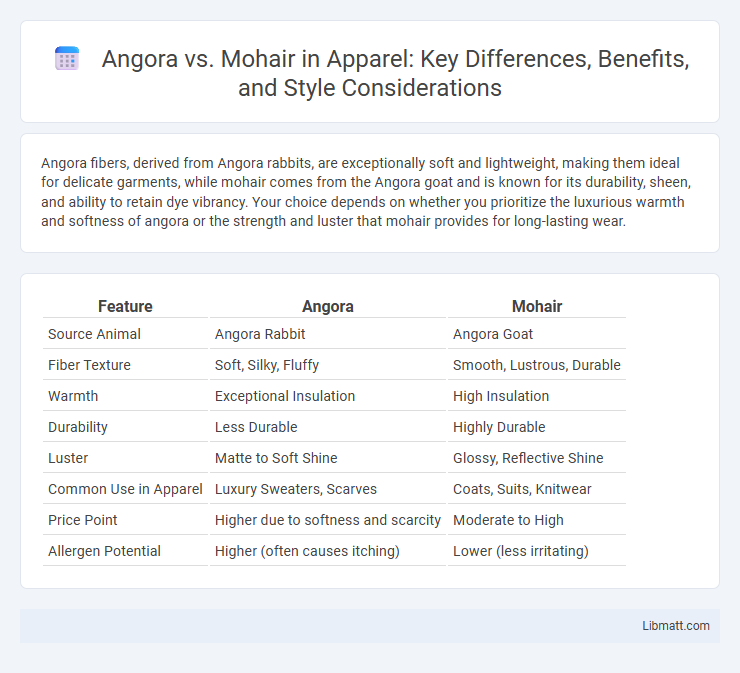Angora fibers, derived from Angora rabbits, are exceptionally soft and lightweight, making them ideal for delicate garments, while mohair comes from the Angora goat and is known for its durability, sheen, and ability to retain dye vibrancy. Your choice depends on whether you prioritize the luxurious warmth and softness of angora or the strength and luster that mohair provides for long-lasting wear.
Table of Comparison
| Feature | Angora | Mohair |
|---|---|---|
| Source Animal | Angora Rabbit | Angora Goat |
| Fiber Texture | Soft, Silky, Fluffy | Smooth, Lustrous, Durable |
| Warmth | Exceptional Insulation | High Insulation |
| Durability | Less Durable | Highly Durable |
| Luster | Matte to Soft Shine | Glossy, Reflective Shine |
| Common Use in Apparel | Luxury Sweaters, Scarves | Coats, Suits, Knitwear |
| Price Point | Higher due to softness and scarcity | Moderate to High |
| Allergen Potential | Higher (often causes itching) | Lower (less irritating) |
Introduction to Angora and Mohair
Angora is a luxurious fiber sourced from the Angora rabbit, prized for its exceptional softness and fluffy texture, while mohair is derived from the Angora goat, known for its smooth, lustrous sheen and durability. Both fibers have been used in high-end fashion and textiles for centuries, offering distinct tactile and aesthetic qualities. The production of Angora is more labor-intensive due to gentle harvesting methods, whereas mohair's longer, stronger fibers provide enhanced resilience in garments.
Origins and Animal Sources
Angora and mohair originate from distinct animals, with Angora fiber obtained from Angora rabbits primarily found in Turkey and France, known for their fine, silky fleece. Mohair is sourced from the Angora goat, native to South Africa and Turkey, producing a lustrous, durable fiber prized in luxury textiles. Your choice between these fibers depends on desired softness, strength, and the specific animal source that aligns with your textile needs.
Fiber Texture and Softness
Angora fiber is exceptionally soft and fine, originating from the Angora rabbit, and is known for its silky texture and warmth. Mohair, harvested from the Angora goat, possesses a smooth yet slightly coarser texture with a lustrous sheen and greater durability. Both fibers enhance luxury garments, but Angora excels in softness while mohair offers strength and resilience.
Durability and Longevity
Angora fibers, derived from Angora rabbits, are known for their softness but tend to have lower durability compared to mohair, which comes from the Angora goat. Mohair exhibits greater resilience and resistance to wear, making it more suitable for long-lasting textiles and garments. Due to its strength, mohair maintains shape and texture over time, whereas Angora requires more delicate handling to preserve quality.
Warmth and Insulation Properties
Angora provides exceptional warmth due to its fine, hollow fibers that trap air effectively for superior insulation, making it ideal for cold climates. Mohair, while also warm, features smoother, stronger fibers that offer moderate insulation but excel in moisture-wicking and breathability. Your choice between Angora and Mohair should consider whether maximum insulation or balanced warmth with durability fits your needs best.
Dyeability and Color Vibrancy
Angora fibers absorb dye exceptionally well, resulting in rich, vibrant colors with excellent color retention over time. Mohair also takes dye effectively, producing bright and lustrous hues, but its smooth surface can cause colors to appear slightly more reflective and less saturated compared to Angora. When choosing between the two for dyed textiles, your preference for deeper pigmentation or subtle sheen will influence the vibrancy and overall appearance of the fabric.
Care and Maintenance Requirements
Angora fibers require gentle hand washing with cool water and mild detergent to prevent felting and damage, while mohair is more durable and can often be machine washed on a gentle cycle. Both fibers benefit from air drying flat to maintain their softness and shape, but mohair is less prone to matting, making it easier to care for in everyday use. Regular brushing with a soft-bristle brush helps remove dirt and maintain the fluffy texture of angora, whereas mohair's low-lint shedding reduces the need for frequent maintenance.
Common Uses and Applications
Angora fiber, sourced from Angora rabbits, is prized for luxury garments like sweaters, scarves, and gloves due to its exceptional softness and insulating properties. Mohair, obtained from the Angora goat, is frequently used in upholstery, suits, and high-end fashion because of its sheen, durability, and elasticity. Both fibers are favored in textile manufacturing for their complementary qualities, with Angora enhancing warmth and softness while Mohair provides strength and luster.
Cost Comparison
Angora typically costs more than mohair due to its labor-intensive harvesting process and rarity, with Angora fibers priced at around $30 to $50 per ounce compared to mohair's $10 to $20 per ounce. Mohair, derived from the Angora goat, is more widely available and less expensive, making it a popular choice for budget-conscious textile projects. Your decision between Angora and mohair will depend on whether you prioritize luxury and softness over cost efficiency.
Sustainability and Ethical Considerations
Angora fibers come from Angora rabbits, which require careful handling to avoid animal cruelty, whereas mohair is sheared from Angora goats, making its harvesting less stressful and more sustainable. Mohair production typically supports better land management practices and lower environmental impact due to goats' adaptability to harsh conditions. Your choice between Angora and mohair can significantly influence ethical sourcing and environmental footprint in sustainable fashion.
Angora vs mohair Infographic

 libmatt.com
libmatt.com